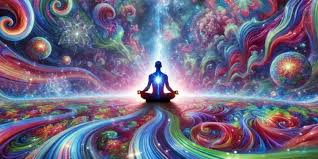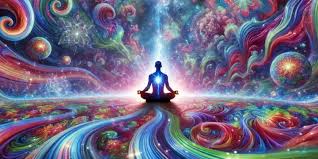DMT and Spirituality: How the Substance Is Used in Shamanic Practices
Introduction: DMT as a Gateway to the Divine
Dimethyltryptamine (DMT) is a powerful, naturally occurring psychedelic compound found in plants, animals, and the human brain. Research on its biological role is ongoing, but DMT has been used for millennia. Indigenous cultures in South America have long regarded DMT as a powerful spiritual tool. Its effects include profound visions and altered states of consciousness. DMT is central to shamanic rituals, believed to open gateways to other realms. It is thought to connect individuals with divine forces, spirits, and their subconscious. This mystical and deeply transformative potential has led to its increasing popularity among contemporary seekers of spiritual and therapeutic experiences. DMT and Spirituality
In this article, we will explore how DMT is used in shamanic practices, the spiritual beliefs surrounding its consumption, and the broader cultural context in which it plays a pivotal role. DMT and Spirituality

The Chemical Nature of DMT: A Gateway to the Spirit World.
DMT is classified as a tryptamine, a type of compound that is chemically similar to serotonin, a neurotransmitter involved in regulating mood, cognition, and perception. DMT’s effects are unique, often described as intense, short-lived, and intensely visual. When consumed, typically through smoking or in the form of an ayahuasca brew, DMT induces vivid, dream-like experiences, often leading to profound changes in consciousness. DMT and Spirituality
What makes DMT particularly significant in spiritual practices is its ability to induce altered states of consciousness that are perceived as experiences beyond ordinary reality. Many users report encounters with otherworldly entities, intense visual phenomena, and experiences of transcendence. In shamanic contexts, these experiences are viewed as communications with spirits, deities, or ancestors, offering insights into personal challenges, healing, and spiritual growth. DMT and Spirituality
DMT in Shamanic Practices: A Tool for Spiritual Exploration, DMT and Spirituality
Moreover, in shamanism, DMT is most commonly associated with the sacred brew ayahuasca, which has been used for centuries by indigenous peoples of the Amazon Basin. Shamans, or curanderos, lead ceremonial rites where participants consume the brew, inducing powerful visions and emotional experiences. These ceremonies are not recreational but deeply spiritual, serving as pathways to healing, wisdom, and self-discovery.
Ayahuasca is made from two main ingredients: the Banisteriopsis caapi vine, which contains harmala alkaloids (MAO inhibitors), and the Psychotria viridis plant, which contains DMT. The harmala alkaloids enable DMT to become orally active by preventing it from being broken down in the digestive system. This combination creates a brew that induces intense visual, auditory, and emotional experiences lasting several hours.
Moreover, in traditional ceremonies, the brew is consumed under the guidance of an experienced shaman. The shaman uses icaros—songs, chants, and prayers—to set the spiritual tone and offer protection. These songs are believed to carry spiritual energy, helping participants navigate their psychedelic journeys and connect with healing spirits.
The shaman plays a key role as both healer and spiritual guide. Seen as someone who can journey between the physical and spirit worlds, the shaman interprets visions and experiences, offering guidance on what participants encounter. The shaman ensures the safety of participants while facilitating communication between the material and spiritual realms.
For participants, the shaman acts as a bridge to the divine. They may experience visions of gods, spirits, and ancestors, which are often deeply emotional and provide healing, guidance, or personal revelations. The shaman’s role is to help interpret these visions and integrate them into the participant’s life, aiding in their spiritual awakening or healing. DMT and Spirituality
Spiritual Beliefs: Healing and Transformation, DMT and Spirituality
Shamans and indigenous cultures view ayahuasca, and by extension, DMT, as powerful spiritual tools for healing and transformation. Moreover, DMT is believed to act as a catalyst, opening the soul to higher knowledge. Additionally, it offers deep insights and creates connections with the spirit world.
Therefore, in shamanic traditions, physical ailments are often seen as the result of spiritual imbalances. Illness may be linked to negative energies, blockages, or disharmony between the individual and the environment. Drinking ayahuasca is thought to help restore balance by guiding individuals through spiritual journeys that heal these imbalances.
The visionary experiences induced by DMT provide access to hidden aspects of the self and the universe. These experiences are believed to offer healing on both physical and emotional levels. Shamans use ayahuasca to help people address trauma, grief, anxiety, and emotional wounds. The intense emotional confrontations that arise during these experiences are seen as essential for purging negative energy and promoting long-term healing.
For many participants, shamanic rituals with DMT bring profound spiritual awakening and self-discovery. The visions during ayahuasca ceremonies often focus on personal transformation, inner wisdom, and connection to the cosmos. Participants frequently report feelings of interconnectedness with nature and insights into their life’s purpose.
However, the path to spiritual awakening through DMT is not always easy. These experiences can be intense, confronting individuals with their deepest fears and unresolved issues. Yet, such confrontations are seen as necessary for personal growth and spiritual enlightenment. By facing these hidden aspects of the self, participants often emerge with clarity, healing, and a deeper understanding of their place in the world. DMT and Spirituality
Modern Interest in DMT and Shamanism
Additionally, In recent decades, the use of DMT and ayahuasca has expanded beyond indigenous and shamanic contexts, attracting people from all over the world. Western seekers, searching for spiritual or therapeutic experiences, increasingly travel to South America for ayahuasca ceremonies. Modern psychedelic research has also increased interest in the therapeutic potential of DMT and ayahuasca. DMT and Spirituality
The growing interest in DMT and ayahuasca is seen as a positive development by some, raising awareness of indigenous cultures. However, it has also raised concerns. Critics argue that commercialization of ayahuasca undermines the spiritual integrity of these practices. The appropriation of indigenous traditions for profit is another issue. There are ethical concerns about the safety of some ayahuasca retreats. These concerns are especially relevant for retreats led by untrained individuals without cultural understanding.. DMT and Spirituality
Conclusion: DMT as a Sacred Tool for Spiritual Growth
Firstly, DMT’s role in shamanic practices is multifaceted: it is a tool for healing, self-discovery, and spiritual awakening. Secondly, for centuries, indigenous shamans have used the substance to guide individuals on profound journeys to the spirit world, seeking wisdom, guidance, and healing. Whether consumed through the ayahuasca brew or in other forms, DMT offers a unique opportunity to explore the depths of consciousness and connect with higher realms. DMT and Spirituality
As interest in DMT and ayahuasca continues to grow in modern times, In as much as, it is important to approach these substances with respect for the cultures that have used them for centuries and a recognition of the deep spiritual and healing traditions they represent. Through careful and mindful use, DMT can continue to serve as a powerful tool for those seeking to understand themselves, their place in the world, and the mysteries of the universe. DMT and Spirituality

